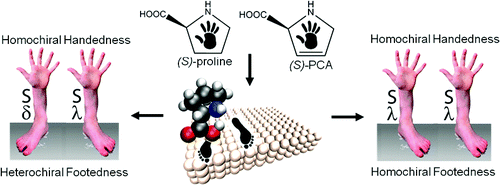
Journal of the American Chemical Society, 133 (2011) 15992–16000

Chirality can be bestowed upon a surface by the adsorption of molecules and is usually discussed in terms of the molecular handedness. However, the adsorption process often leads to a new manifestation of chirality in the form of the adsorption footprint, which can also be chiral and generate mirror-images in 2-D. Therefore, in describing the chirality of the interface, one must consider both the handedness and the adsorption "footedness" of the system. Specifically, the creation of a truly homochiral surface must ensure that a single chirality is expressed for each aspect, and requires not only the control of molecule handedness but also direct control over footedness. Here, we demonstrate the ability to engineer homochiral footedness by a structural modification of enantiopure (S)-proline, which normally creates a (4×2) organization on a Cu(110) surface with heterochiral footedness. This modification of proline via the addition of a double bond within the pyrrolidine ring, yielding 3-pyrroline-2-carboxylic acid (PCA), is sufficient to drive the footprints of the entire (4×2) assembly from heterochiral to homochiral, leading to the creation of a truly homochiral interface The effects of modifications upon the footprint arrangements were characterized at the single-molecule level by scanning tunnelling microscopy, reflection absorption infrared spectroscopy and periodic density functional theory calculations. The control of adsorption footprints is not only pivotal to tailoring chirality at surfaces but also plays a key role in dictating the organization, the outward facing functionalities and the response of the organic-inorganic interface.
The American Chemical Society holds the copyright for the published article. More information can be found on their website.
Limitted copies of the full text are available through the ACS Articles on Request service by following this link.
1Surface Science Research Centre and Department of Chemistry, University of Liverpool, Liverpool, UK
2Department of Applied Physics, Chalmers University of Technology, SE-412 96, Göteborg, Sweden